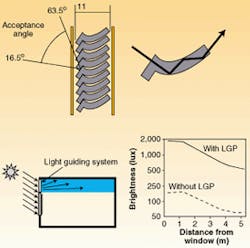Incorporating news from O plus E magazine, Tokyo
TOKYO-An optical system developed by Item-16 Co. efficiently directs natural light to rooms. Termed light-guiding profiles (LGPs), the technology creates a comfortable indoor climate while reducing the use of electricity.
Rooms with southern exposure are subject to direct sun, and because of harsh light and overheating, do not provide ideal living and working conditions. Blinds and curtains can shut out the sun, but because the room becomes too dark as a result, interior lights are required. Light-guiding-profile technology helps to get rid of this irony. An LGP is placed on the top part of a window, channeling natural light into the room and providing enough lighting. There have been attempts to use natural light in similar ways in the past, but because of the limited incident angle of solar light, light-collection efficiency was low. This system utilizes carefully designed optical components shaped so that light is collected for about seven hours a day.
In a cross-section of the optical system, long, thin prismatic optical components made of transparent polymethylmethacrylate plastic are stacked on top of each other and sandwiched between sheets of glass (see figure). Each so-called profile has a width of 11 mm, a height of 2.8 mm, and a length of 330 mm. For a column 1 m high, 360 profiles can be stacked on top of each other. Each profile is shaped so that the device can accommodate light entering between angles of 16.5° and 63.5°. Thus, light can be collected from between approximately 9 am and 4 pm. Each square meter of profile can light a 20-m2 area. The external glass panels can be easily cleaned, and as there are no moving parts, maintenance is minimal.
Components are shaped to direct sunlight efficiently toward the ceiling of a room; in use, a stack of such components is mounted between two sheets of glass (top). Distribution of brightness of a room as a function of distance from a window that incorporated LGPs in its top portion was measured on a sunny day in a south-facing room at noon (bottom left). The elevation of the sun was 63°; brightness was measured on a desk 85 cm above the floor. Even though the window had blinds, a brightness of 500 lux was achieved 5 m away from the window (bottom right).
Many offices currently lower their blinds to shut out natural light and use electric light to compensate. By installing LGPs along with reflectors on the ceiling that direct light toward the desks, it should not be necessary to use electric lights at all times. Even when electric lights are needed, the ceiling reflectors can provide partial illumination, reducing energy expenditure.
Courtesy O plus E magazine, Tokyo
